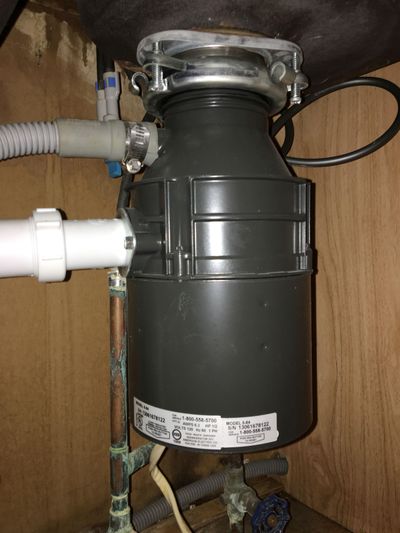Ask the Builder: Garbage Disposal 101

Q. Dear Tim, I averted a near Christmas Eve disaster. I was making 75 deviled eggs for 30 guests who were soon to arrive. I turned on my disposal to grind up the eggshells and ended up with a pool of smelly egg water in the sink! I was able to get the water to drain after 45 minutes of plunging.
My 1-year-old granddaughter’s squeals of delight from her highchair as the plunger went up and down buoyed my sinking spirits. What are the do’s and don’ts of using a disposal so the plumber isn’t on the guest list at my next party? How can I keep my disposal smelling fresh? – Mary Gene K., Cincinnati
A. Plumbing disasters like this during a party or large family gathering are more common than you might think because the extra people at your home create a higher volume of water in the kitchen and bathroom. This extra amount of water and waste often overwhelms partially clogged plumbing drain lines.
I have a love/hate relationship with garbage disposals. They’re handy machines if you don’t like to throw food scraps away, but they can wreak havoc on plumbing drain systems when used improperly.
Allow me to explain what happens when you use your garbage disposal using an imperfect analogy. Imagine a giant ready-mix concrete truck filled with a slurry of sand, small rocks and water. Drop the chute and discharge this mix into a 12-inch-diameter city sewer.
If you don’t add a significant volume of clear water immediately after dumping the sand and gravel into the sewer pipe, the pipe will start to choke off. The clear water is needed to transport the sand and gravel to the end of the pipe.
Use a clear food blender to create a more realistic example of what happens inside your disposal. Save about a pint or even a quart of food scraps that you’d normally shove into the dark black hole of the disposal.
Add enough water to the blender to make a food-scrap smoothie. This food sludge is exactly what your disposal creates – and you hope it’s going to magically flow down your kitchen drain line!
Eggshells and celery are two of the worst things you can put down a kitchen disposal. The eggshells resemble the small rocks and sand I described above. Celery has tough fiber strands that can get wrapped around the moving parts of the disposal. I’d never put either of these food scraps down a disposal.
It’s very important to understand that the inside of many kitchen drain lines is by no means smooth and wide open. The insides of old galvanized iron drainpipes develop a scale over the years.
A steel pipe that originally had an inside diameter of 1 1/2 inches might only have an inner diameter of 1/2 inch or 3/4 inch after years of use. I’ve seen these horizontal and vertical pipes completely choked off with deposits.
Modern plastic PVC or ABS plastic pipes can also have deposits, especially hardened grease, clog them. Expecting a slurry of ground-up food scraps to flow like water through partially clogged drain lines is akin to expecting three people to pass smoothly through a conventional doorway at the same time.
In my opinion, the best way to use a garbage disposal is to add the food scraps you wish to grind up and then place the stopper at the top of the opening so you can fill the sink halfway with water. Once you have added the water, pull the stopper out and immediately turn on the disposal.
The spinning cutting heads in the disposal transform the food into a slurry, and the weight and volume of clear water in the sink starts to force it through the drain line. The added benefit is that the clear water rinses the sides of the disposal as the last food leaves the machine on its way to the sewer plant. I’d then allow the water from the faucet to run at least another 30 seconds after all the water has emptied from the sink.
I’m not a big fan of using a garbage disposal with a septic system. There are two schools of thought to this, and years ago a major disposal manufacturer created a disposal that dispenses special enzymes to help gobble up the slurry once it hits the septic tank.
Installing a new leach field is very expensive if you overwhelm your septic tank with organic material. It’s just so much easier, in my opinion, to compost food scraps or throw them away.
The secret to a fresh-smelling garbage disposal is to keep all the inside parts clean. You do this by making sure the disposal is rinsed with clear, or even soapy, water after it’s ground up the food as I described above. It’s not hard to imagine the vortex of spinning water, much like you see in a blender, that’s rinsing the sidewalls of the disposal as the water leaves the sink on its way to the drainpipe.
Here’s another tip to prevent party disasters. Every two months or so, I pour 10 gallons of boiling water down my kitchen sink to help keep the insides of the drainpipe as clean and grease-free as possible.
I save partially soiled paper towels and use those to sop up grease from all pots, pans and plates so I put as little grease as possible down my drain lines. While we plumbers are almost all great guys, we want to be with our families during Christmas, not on our knees taking apart your kitchen sink drain lines!
Subscribe to Tim Carter’s newsletter and listen to his new podcasts. Go to askthebuilder.com.